Pearls, no matter whether they are natural, cultured, or imitations pique the curiosity of almost everyone interested in jewelry. (when I taught gemology, the pearl class was always the most popular.)
Most people are fascinated when they hear the details of how they form and the differences among the various varieties of cultured pearls. They are also confused by the huge price variations between pearl strands or jewelry pieces that may look quite similar.
I guess the best place to start is to give you a brief overview of how natural pearls and cultured pearls are formed and how they differ.
Defining Pearls
Pearls, whether cultured or natural, form due to the same circumstance. When an irritant, usually a parasite, finds its way through or into the shell and settles into the body of the oyster or mussel. It will protect itself by forming a sac around the foreign matter. And to further protect itself, it will continue to coat the irritant with layer upon layer of the same organic liquid that hardens to form the pearl’s smooth, hard surface on the inside of the shell.
Nacre
Nacre is the liquid substance that is secreted from the mantle tissue that coats the rough interior surface of the shell where the oyster lives. The nacre hardens to form a beautiful iridescent surface called Mother-of-Pearl.
The difference between natural and cultured pearls is the circumstance that triggers the pearl's formation. A cultured pearl is man's partnership with nature and is formed when technicians surgically implant the irritant rather than the process occurring naturally at the bottom of the sea.
Technicians on cultured pearl farms implant mother-of-pearl bead nuclei within the bodies of oysters along with a piece of mantle tissue that grows around the bead forming a sac. This tissue secretes nacre and the mollusks are returned to the water to allow the cultured pearls to grow. BTW, if you have a steady hand, this job may interest you as these technicians are paid more than a million dollars a year!
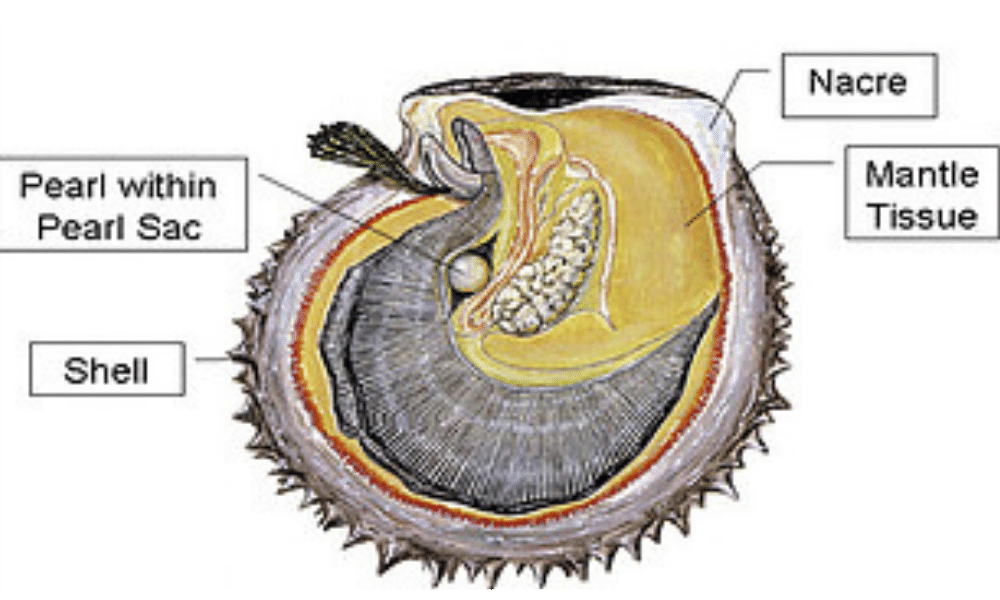
What Kind Of Pearls Do I Have?
You might assume that the strand that was passed down to you from your mother or grandmother has a great deal of intrinsic value. That is not always the case. With all the different varieties of cultured pearls and imitations out there, it is hard to know what exactly you are looking at. But what is important is the sentimental value of jewelry that has been passed down; you cannot put a dollar value on family heirlooms.
Natural Pearls
As described above, natural pearls are created spontaneously, without man's help or intervention.
Cultured pearls are produced on pearl farms, where man induces the process, controls the environment, and baby-sits the oysters until they form cultured pearls, anywhere from six months for Akoya to three years for South Sea cultured pearls.
For natural pearls to reach substantial sizes takes years and years. Natural pearls will be 100% nacre; the only way to determine if pearls are natural is by X-ray or by slicing them in half. There are few natural pearl strands left today, and most are found in museums. The misconception is that natural pearls will be perfect, which is really not the case, but regardless they are extremely expensive due to their rarity.
Prior to the mastery of the culturing process in the early 1900s (by the "King of Pearls" Mikimoto), the only way to obtain pearls was for divers (mostly women) to to plunge to the bottom of the ocean floor and collect oysters in the wild, in the hopes of finding pearls once they opened the shells! Due to the high demand for pearls, the oyster beds were eventually depleted.
The number of willing divers also dwindled due to lung diseases that severely shortened their lives. Luckily Mr. Mikimoto's successful new process brought beautiful cultured pearls into the marketplace and filled the demand. Cultured pearls only become popular in the U.S. after WWII, when servicemen returning from Japan brought gifts of cultured pearl strands back to present to their wives.
Cultured Pearl Varieties
Here is a list of the varieties of cultured pearls and the major sources. If you have pearls and are unsure of the variety, take a look at the information below, it might help you identify your strand or piece of jewelry that features pearls.
Freshwater
China, U.S. (limited): are produced with or without bead nuclei, they can be produced by just inserting pieces of mantel tissue inside the freshwater mussel (as many as 17 pearls can be produced per shell.
- Abundant, pastel colors, accessible and affordable, are the keywords to describe freshwater cultured pearls - They are the mainstay of contemporary pearl jewelry design.
- The The technology used to culture freshwater pearls today is amazing; these pearls rival the beauty and luster of Akoya pearls as well as their high prices, that are far more accessible! Sizes: 6mm-12mm.
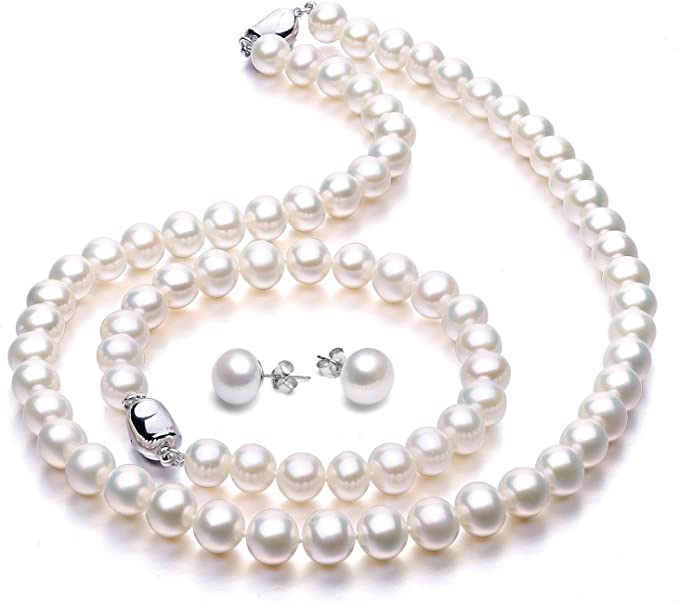
Freshwater Cultured Pearl Necklace Set Includes Bracelet and Stud Earrings
These freshwater pearls are absolutely stunning and a fantastic holiday gift presentation. The necklace is an 18-inch perfectly matched strand, 7.5-8.5mm, with matching bracelet. The classic stud earrings are 10-10.5mm. All three pieces are set in sterling silver. Treat yourself or someone you love to these beauties! Click below for additional information.
Akoya (name of the oyster)
Japan, China: Prized for their high luster, the finest have mirror-like reflections, white or rosé, with rosé overtones. Sizes: 2mm-10mm (9mm-10mm extremely rare.) Grown in saltwater pearl farms, the oysters are implanted with various size beads (that determine their ultimate size) and cover the beads with nacre. Today because of the success of freshwater pearls, their abundance, beauty and low price points, Japanese Akoya cultured pearls are declining in popularity.
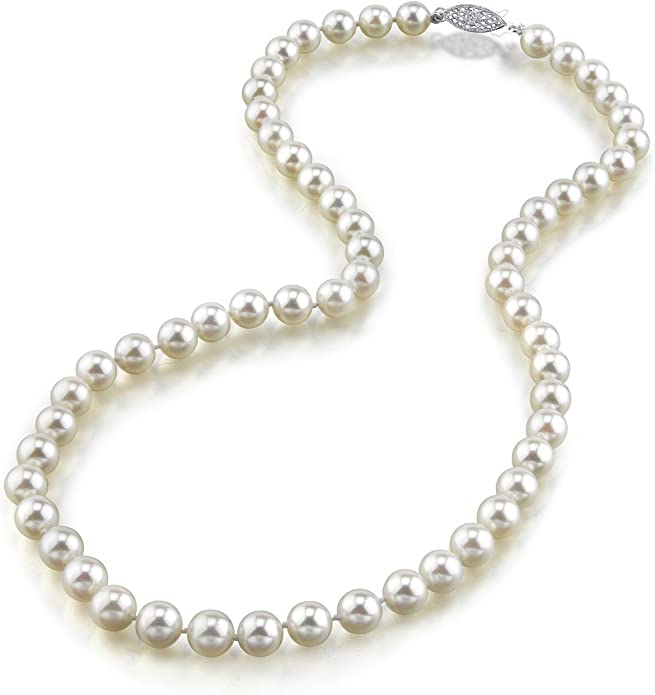
THE PEARL SOURCE 14K White Japanese Akoya Saltwater Cultured Pearl Necklace
This 16-inch Akoya choker is matched for size, color, luster, and surface thickness and quality. This strand makes a stunningly elegant gift; the pearls are 6-6.5mm with a 14K white gold filigree clasp. Click below for additional details.
South Sea
Australia, Indonesia, Philippines: Cultured South Sea pearls are the largest and rarest variety of pearls and are known for their satiny or silky luster. The finest have very high luster. Colors: White, silver, or golden. Sizes:10mm-20mm. Their premium prices are due to several factors:
Value Factors For South Sea Cultured Pearls
The rarity of the oyster (Pinctada Maxima)
The limitations imposed by the Australian government on production
The enormous infrastructure, ships and sea planes required to establish and maintain farms
The extraordinary size and beauty of these pearls
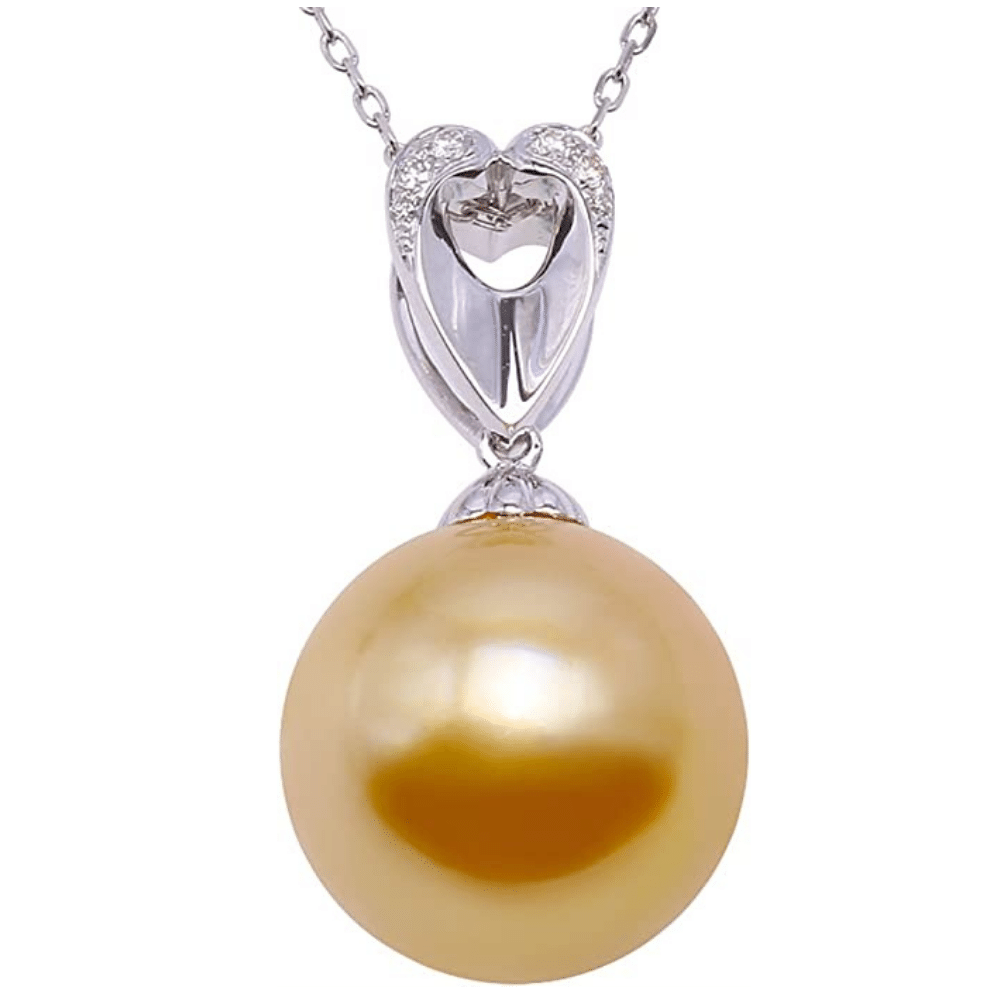
18K Gold Pendant AAA+ Quality 12mm Golden South Sea Cultured Pearl Pendant
This pearl is a rare golden color, white South Sea pearls are three times more abundant. Set in 18K white gold, or yellow. The large size and beautiful luster will be appreciated by all pearl lovers. Click below for additional images and price.
Tahitian – Black South Pacific
French Polynesia (Tahiti and surrounding islands) Metallic luster - Although many think of Tahitian pearls as having a black body color, they form in a variety of colors in dark shades of gray, green, brown, and blue, with green and/or purple overtones. Sizes: 8mm-18mm
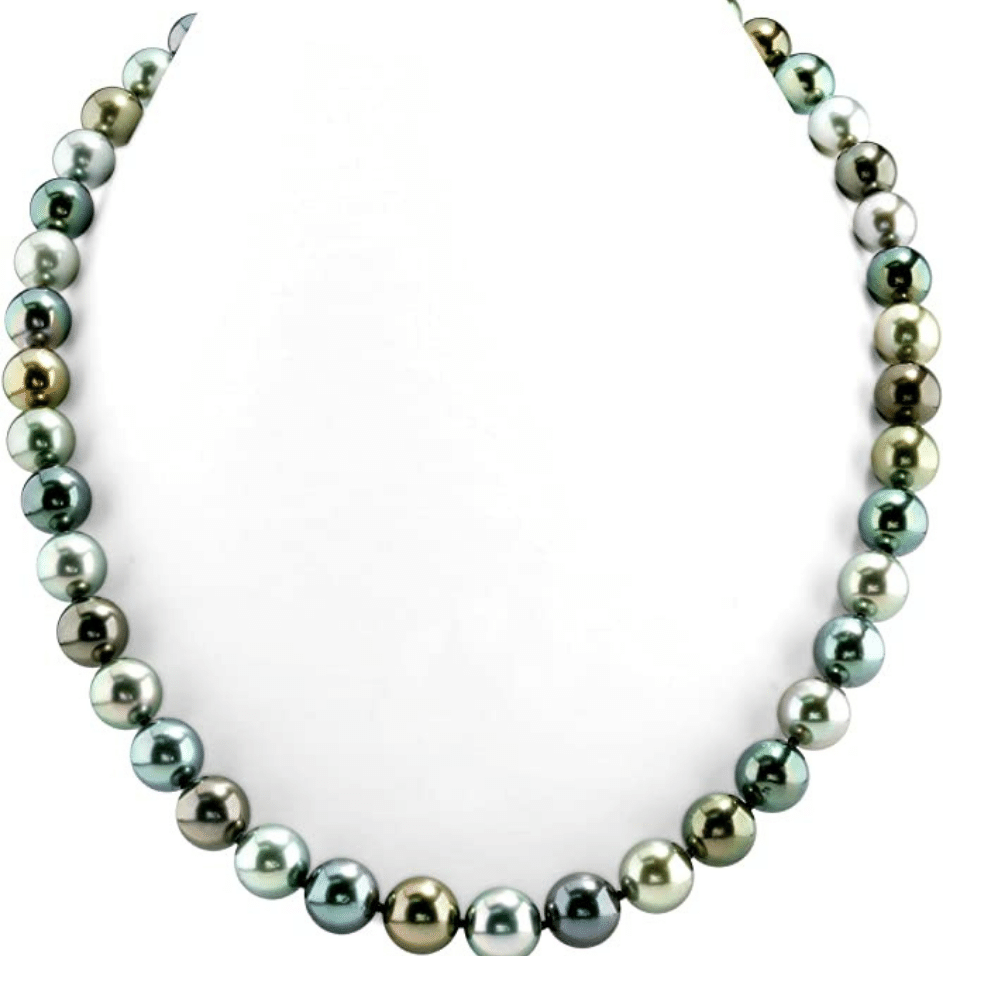
THE PEARL SOURCE Multicolor Tahitian Cultured Pearl Necklace
The colors and luster of these pearls are unrivaled! Their metallic luster is mesmerizing. The pearls are 8-10mm in size and the strand is 17 inches in length, with a 14K yellow gold clasp. Matched for size, luster and surface quality, the colors are chosen to complement each other and create visual harmony. Click below for the detail.
Keshi
Baroque (interesting and unique shapes) pearls that can form as a by-product of the culturing process, the most valuable come from South Sea and Tahitian oysters and most often have very high luster. Sizes: 2mm-10mm
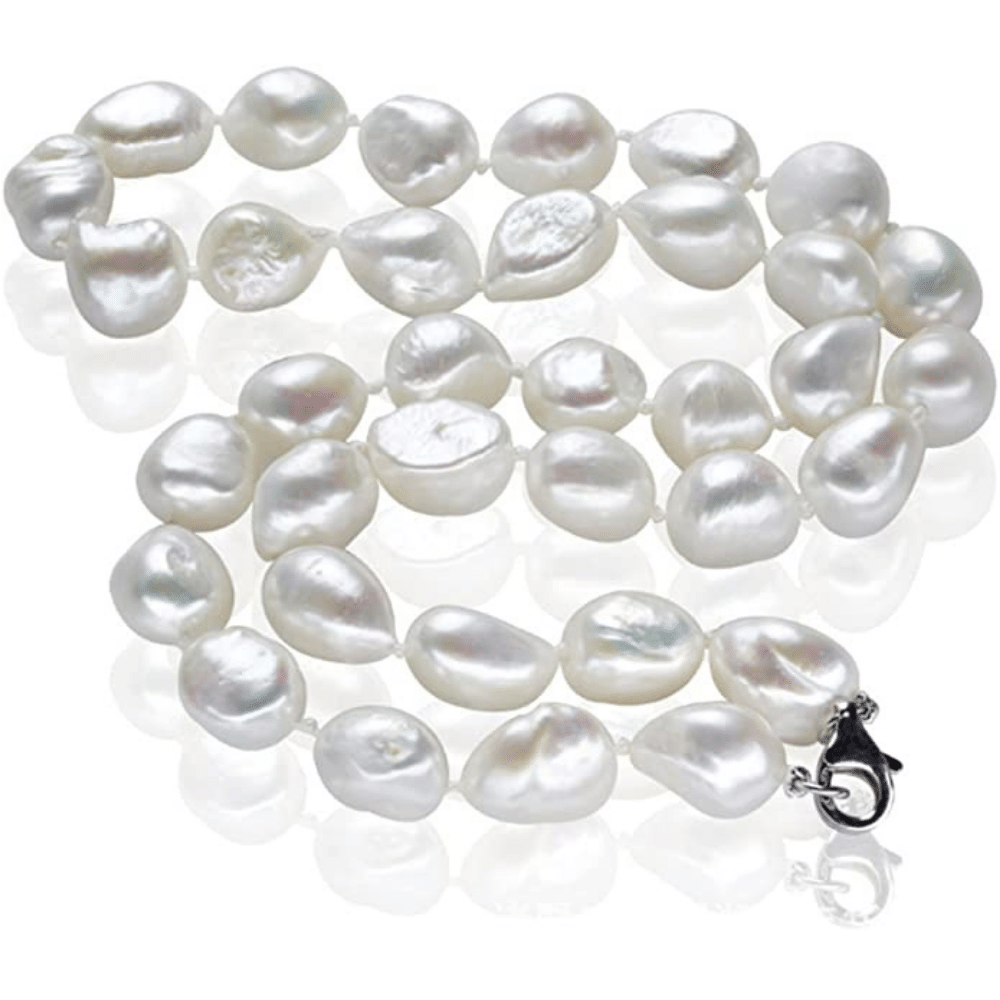
Pearl Necklace White Freshwater Pearl Necklace
This Keshi (baroque) freshwater necklace is amazing. Each pearl has its own individual character. The necklace has a sterling silver clasp and is 18 inches long. Click below to learn more, the price will shock you!
Mabé Pearls
Formed by attaching a plastic form (half-sphere) inside the shell of South Sea oysters, along with mantle tissue that covers the form with nacre. After one year the form is cut away and backed with a piece of mother-of-pearl. Most often used to make earrings. They are also known as assembled pearls.
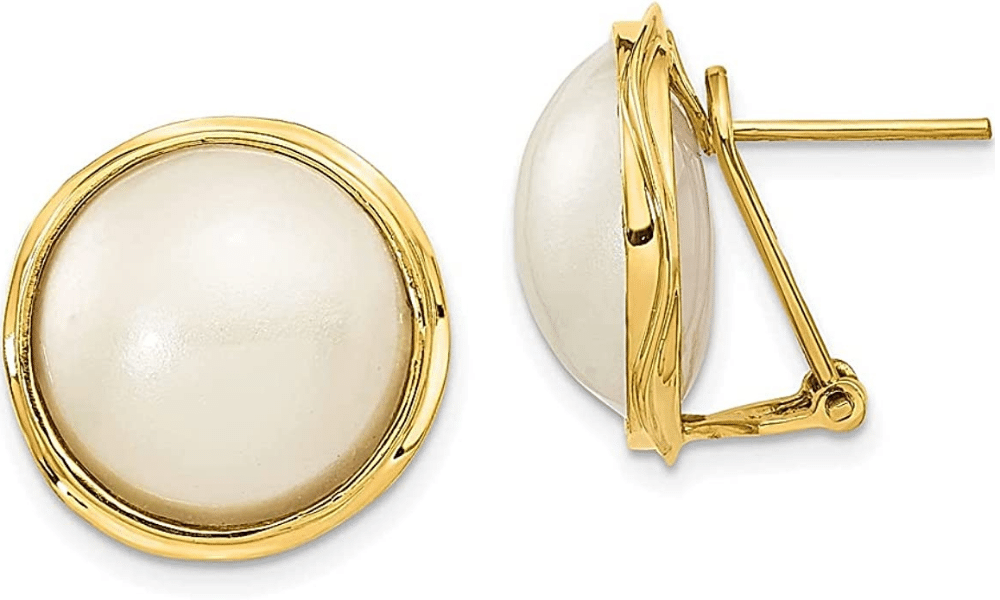
14k Yellow Gold 14-15mm White Freshwater Cultured Mabé Pearl Earrings
These beautiful mabé pearl earrings are so classic in design and a must have for your jewelry wardrobe. Settings are 14K yellow gold, with an Omega back for extra security. Don't have pierced ears? any jeweler can easily remove the gold pin. Click below to learn more about these amazing earrings.
Seed Pearls
2 millimeters or smaller – no bead nucleus, these are natural, but a by-product of the culturing process

Mother-of-Pearl
The nacre coating that lines the inner shell of oysters. Used in jewelry, to make buttons, guitar frets and ornamental objects.
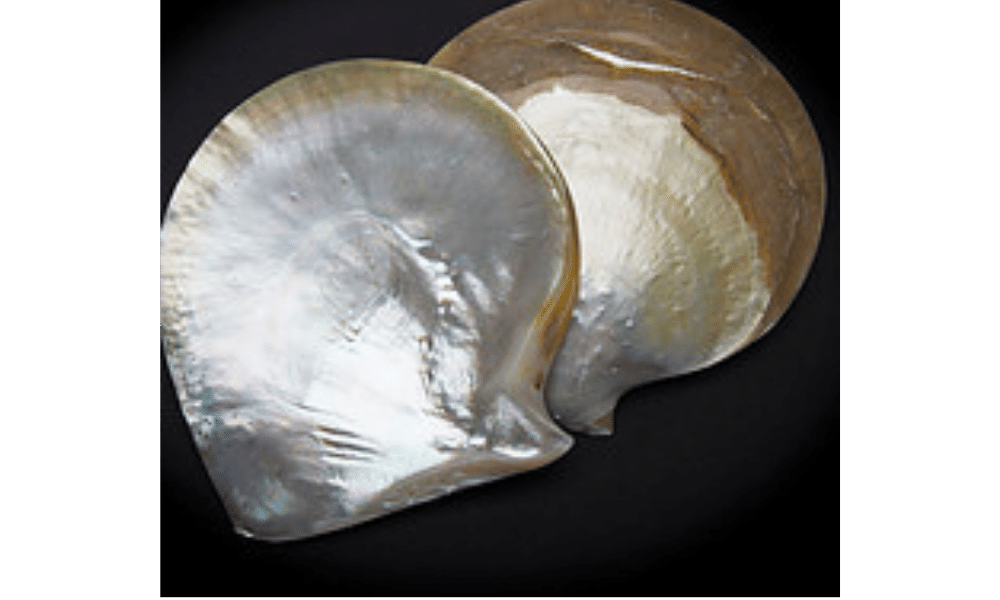
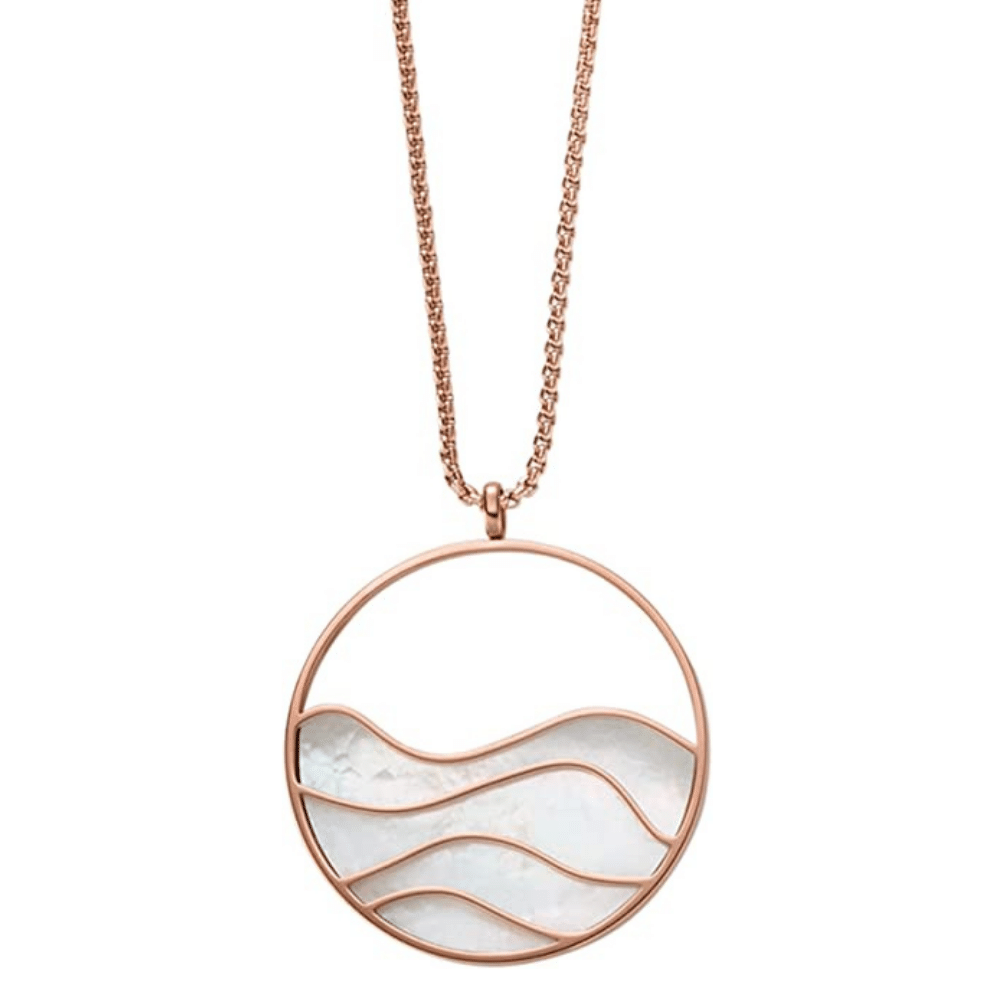
Women's Rose Gold Stainless Steel Pendant Necklace
Super modern, minimalist design. Chain and frame, stainless steel with rose gold tone. The iridescence is magnificent as it reflects the colors of the rainbow. The chain features a secure lobster claw clasp; and can be adjusted to choker length. Click below for this fantastic offer.
Cultured Pearls' Value Factors:
All cultured pearls are assessed for the following factors:
- Size: Cultured pearls range in size from approximately 2mm - 20mm. Larger sizes are the rarest, as are small sizes in some varieties.
- Color & Overtones: The body color (first color we see) Overtones, the sheer color(s) that lie over the body color. Example: White with rosé (pink) overtones or dark gray with purple or green overtones, etc.
- Luster: Surface shine and reflections – Cultured pearls can have dull to very high or metallic luster.
- Shape: round, near round, symmetrical, baroque - round pearls are the rarest, thus the most expensive shape within each variety – example: a round South Sea cultured pearl is more expensive than a near round, etc.
- Surface Complexion: bumps, cracks, pits in the nacre coating - Blemish-free cultured pearls are the rarest – because they are an organic material, blemishes are very common. Luster is the most important. It has been said that a flawless pearl is as rare as a flawless diamond.
- Nacre Quality/Thickness: Can only be measured by x-ray or by cutting the pearl in half - The bead nucleus should not be not visible through a good nacre coating.
- Matching: In strands, or any piece with multiple pearls, the factors above are matched as closely as possible.
Keep in mind that cultured pearls are organic (formed from a living organism) so as you look at strands, no two pearls will be exactly alike - there will be slight variations in color, size, and luster. The goal is to match pearls to create strands with visual harmony.
Imitation Pearls
An imitation is something that just looks like something else. I remember when I was very young, we had pearl necklaces made of plastic where the beads snapped together and we could make them any length we wanted. Oh how grownup and glamorous we felt.
More sophisticated imitations, like glass beads covered in pearlescent solutions that imitate nacre coatings have been around for more than 100 years. They are covered with clear lacquer or other coatings to protect the surface. The tip-off for these imitations is that the beads, "pearls" are heavier and over time the lacquer coatings tend to turn yellow and or chip off. The highest quality imitation pearls are produced by a company named Majorica®, located in Majorca Spain, They have been producing imitation pearls since 1890. These imitation pearls will last a lifetime if properly cared for. Click Here to learn more about Majorica® imitation pearls.
Caring for Cultured Pearls
- Do not wear pearl strands with any other jewelry that will scratch the delicate nacre coating.
- Do not expose to hairspray, fragrance, or body lotion
- Do not store in safety deposit boxes for long periods of time (years) the nacre coating will dry out and crack
- Remove pearl jewelry prior to playing sports or to clean house
- Pearls should be the last thing you put on and the first thing you take off
- Always store in the original packaging or soft lined pouch
- Professionally cleaning and restringing is recommended once a year if you wear your strands often
- When caring for pearls at home, wipe with a soft, slightly damp cloth
- There are mild liquid jewelry cleaners that are safe for cultured pearls. See our article The Best Jewelry Cleaning Kits
Conclusion
If your question was "What is the difference between cultured pearls and real pearls?" I hope you found this article enlightening! There is nothing more alluring than pearls and they should be a staple in every woman's jewelry wardrobe, but men have begun to appreciate pearls as well, they are not just for women anymore!
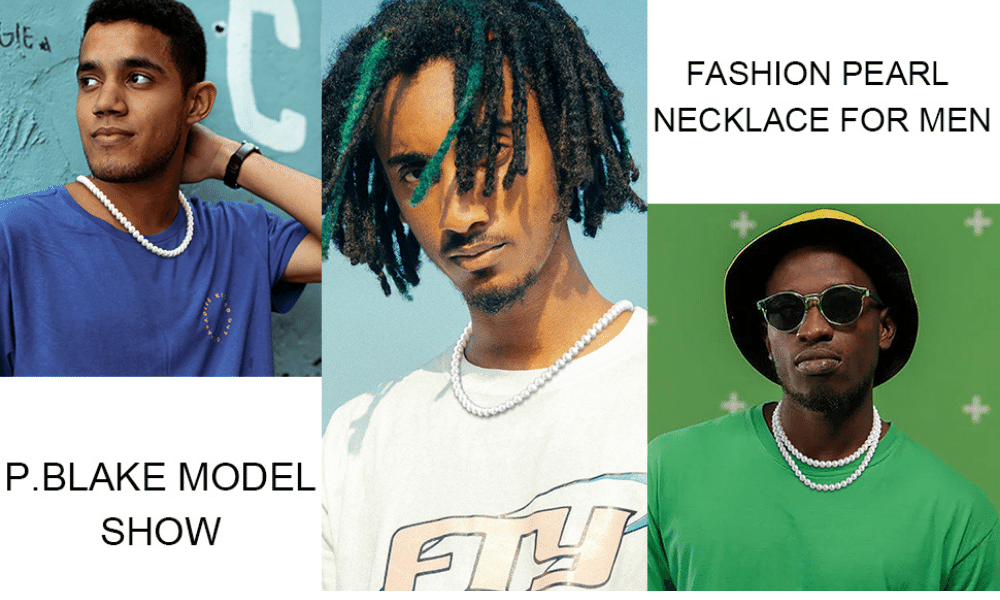
FAQs
Are South Sea pearls the same as Tahitian pearls?
No, South Sea Cultured Pearls are grown in Australia, Indonesia, the far east. Tahitian Cultured pearl farms are located in the islands surrounding Tahiti and the Cook Islands. In addition, the mollusks are different, with the Tahitian mollusk being smaller than the Australian mollusk.
How can I tell what type of pearls I have?
The best way is to take them to a qualified jewelry appraiser to determine what type of pearls they are. The only sure way is to obtain an X-ray. If you have a close relationship with your dentist, they might be able to help you.
Is it safe to clean my pearls in a liquid jewelry cleaner?
Yes, if the cleaner says it is safe for Pearls. Also, be sure to lay the pearls on a soft cloth after cleaning to dry completely. Examine the strand to ensure the material used to string the pearls is not frayed or stretched.
Thank you for reading my article!
Francesca de Granville, G.G, F.G.A.

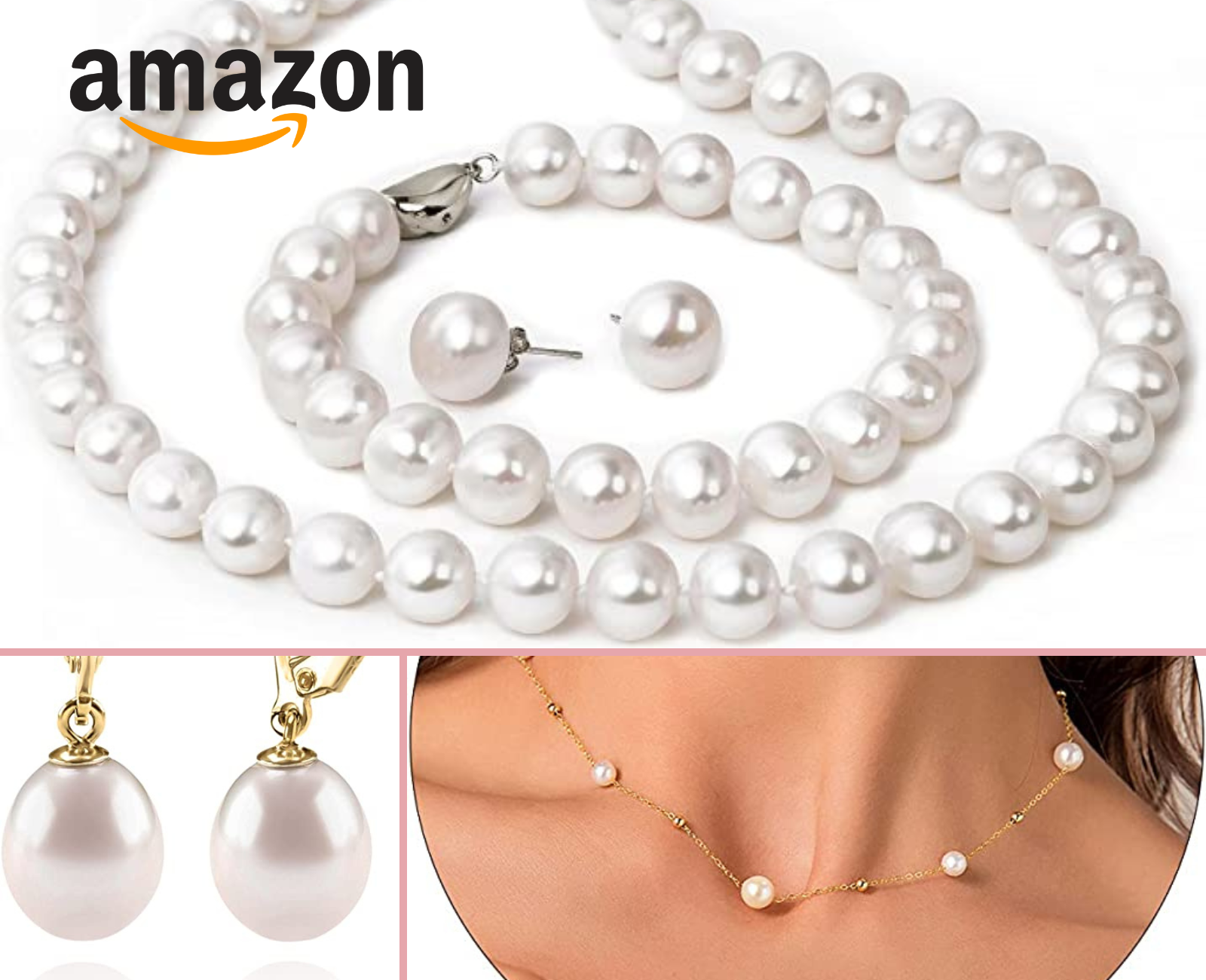
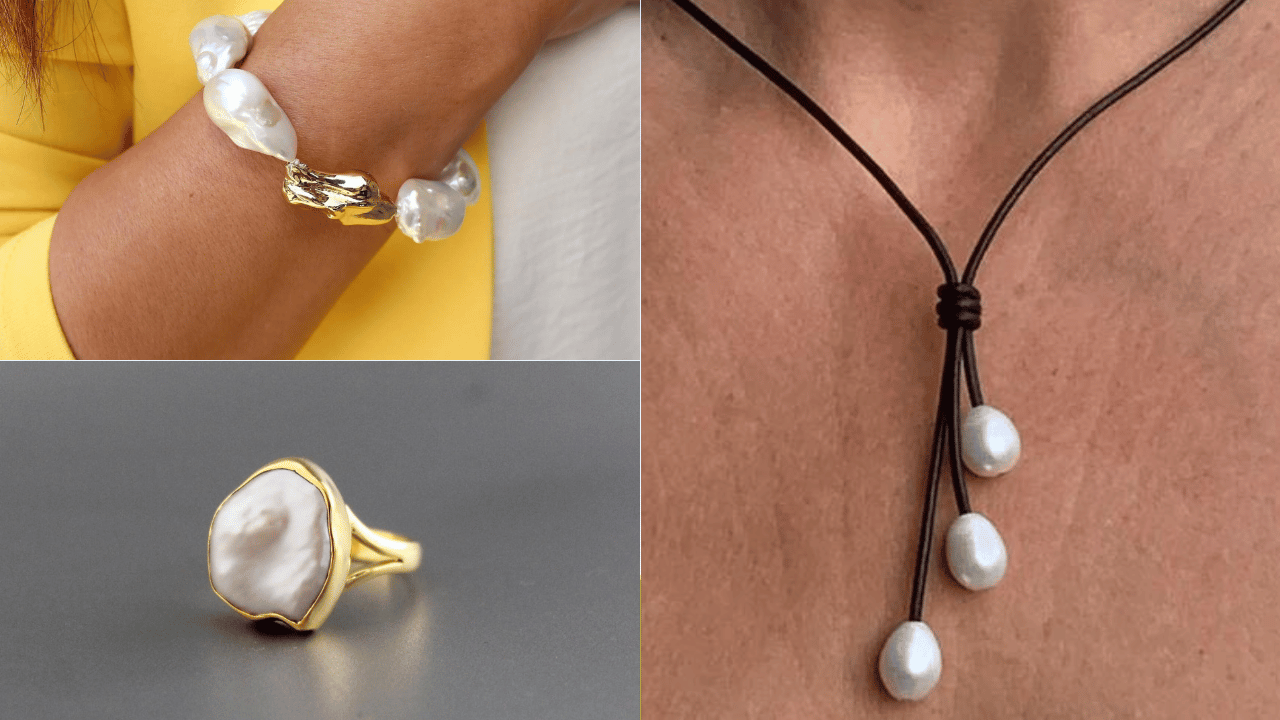


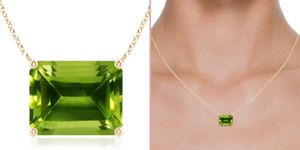
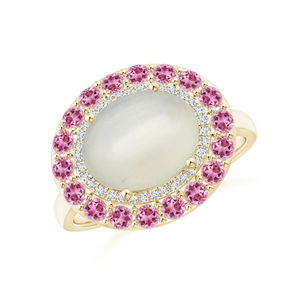



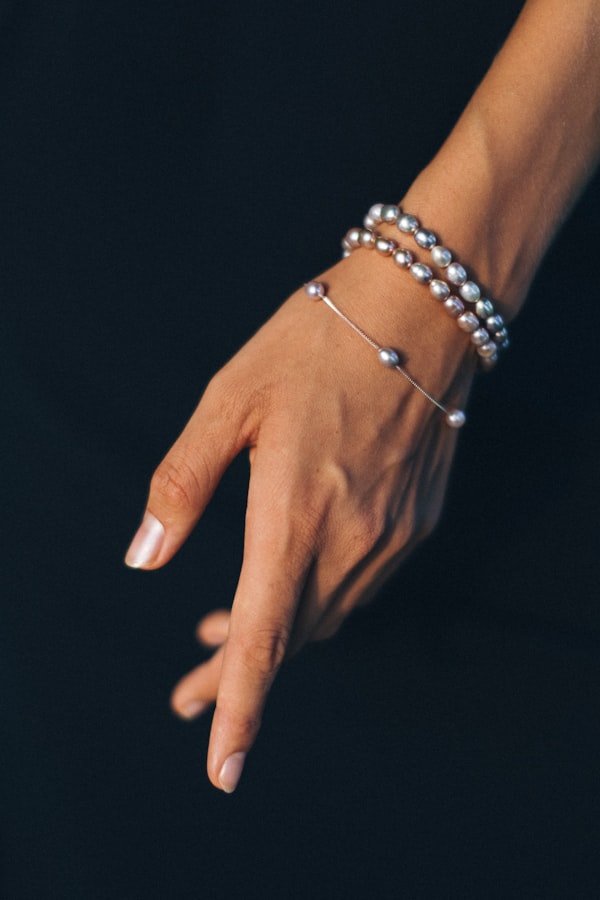
Member discussion